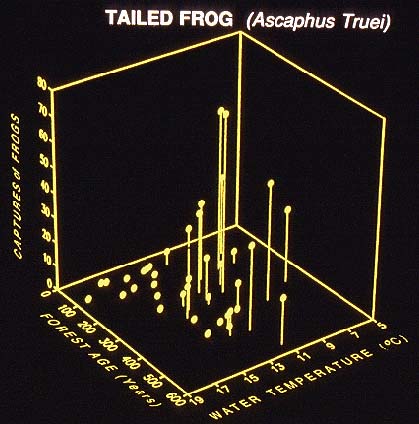 |
Bibliography | Background | Hypotheses | Home |
 |
Bibliography | Background | Hypotheses | Home |
![]()

Tailed frogs are most abundant in old growth forests, where water temperatures remain cool. Note that few frogs were found in forests less than 100 years old, or in forests older than 100 years where water temperatures rise above 15 degrees C. Tailed frog eggs cannot survive temperatures in excess of 18.5 degrees, and this temperature may be attained if forest canopy is removed through logging. Data are from H. Welsh, U.S.F.S. - PSW, Redwood Sciences Lab, Arcata, CA.
![]()
Graphs and photographs from Dr. H. H. Welsh, Redwood Sciences Lab
From the Mattole River Basin:
Richness of amphibian species in 3 forest cover types (47 KB)
Air temperatures vs. distance from stream for three forest types (45 KB)
Abundance of Black Salamanders in perennial and intermittent streams (40 KB)
| Examples of the three forest cover types in the Mattole River basin: | ||
| Late seral | Second growth | Second growth and grassland mixed |
From regional studies:
Number of tailed frogs plotted against age of forest and air temperature (45 KB)
Abundance of So. torrent Salamander vs. % canopy (35 KB)
![]()
|
Table of Contents for Background Pages |
|||||
| Stream Conditions: | Water Quality | Sediment | Riparian | Big Wood | Habitat Types |
| Watershed Conditions: | Vegetation Types | Slope Stability | Roads & Erosion | Cumulative Impacts | Urbanization |
| Fish & Aquatic Life: | Fish Populations | Amphibians | Aquatic Insects | Hatcheries | Fish Disease |
| Restoration: | Stream Clearance | In-stream Structures | Riparian | Watershed | Strategy |
| Geology / Hydrology: | Geology | Soils | Precipitation | Stream Flow | Channel Processes |
| Policy & Regulation | ESA | TMDL | Forest Rules | 1603 Permits | Water Rights |
| www.krisweb.com |